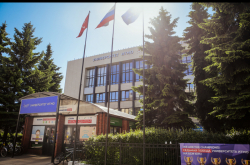Universities in the ranking are assessed by six criteria: education, research, social environment, international and interregional partnership, innovations and branding. The first criterion concerns the students’ average grades, number of organizations involved in education, and other aspects. The second criterion, research, depends on the number of a university’s Master’s and PhD programs, citation rates, volume of research, etc. “Social environment” is determined by the staff’s salaries, student infrastructure, and social programs. Internationalization rates are assessed according to the number of international students and research partners. Innovations are: patents, departments, R&D projects, entrepreneurial events and other initiatives. Finally, a university’s brand is evaluated by the number of mentions in other media and the effectiveness of various university-organized events.
“This ranking’s methodology is, probably, one of the most expansive and complex out of all the others. It includes six parameter-based rankings, each based on five to eight sub-criteria. One distinguishing feature is that the Interfax ranking doesn’t have a survey component, which tends to be a key area in such international rankings as QS WUR (where it accounts for 50% of an evaluation) and THE WUR (more than 30%). In the Russian ranking by RAEX, respondent data from graduates and academics also accounts for some 30% of the final result,” – comments Ilya Kuftiryov, head of ITMO University’s Rankings Research Center.

Analysts from Interfax use various public data on the universities’ activities, their scientific performance and the results of monitoring conducted by the Ministry of Education and Science. Interfax’s SCAN (system for complex analysis of news) also provides certain data. Some information is provided by the universities. Alexey Gorshkov, CEO of Interfax, noted that the competition is the most heated among high-profile universities that possess their own strategic development programs and the necessary resources. He pointed out that universities participating in the 5-100 Russian Academic Excellence Project are especially notable.
This year, ITMO University has preserved its status as a top-10 university, securing ninth place. It also improved its performance in the “Innovations & Entrepreneurship” and “Internationalization” criteria. In the first ranking, ITMO University moved up five positions and is now 8th among Russian universities. The second ranking has the university’s best result: it placed second, moving up three positions as compared to last year’s ranking. The university’s excellent internationalization efforts have already been made evident in other rankings, such as Times Higher Education and the QS BRICS ranking. With each year, ITMO University increases the number of its international staff and students, as well as the percentage of articles co-authored with foreign colleagues. According to Scopus’s SciVal analytics platform, in 2017 this number reached 49% and is currently the highest among other leading participants of Project 5-100. ITMO University’s performance in the “Research” ranking also remains steadily high: for the second year in a row, ITMO took fourth place.

“The main growth points for us are “Social Environment” and “Education”. ITMO University already has a great track record in regards to working with school students, the number of entrants, variety of educational programs and other indicators evaluated by most rankings. Core changes in educational activity and the creation of comfortable educational conditions are strategic goals for ITMO University, and are part of its Road Map for Project 5-100. We expect the results of these initiatives to be reflected in results of future Interfax rankings,” – noted Ilya Kuftiryov.
Just as it did last year, the Moscow State University took first place in the ranking. The second place went to the Moscow Engineering Physics Institute (MEPhI). In the third place is the Moscow Institute of Physics and Technology, which has taken over from the St. Petersburg State University, which is now fourth. After that is the Higher School of Economics (5th place), Novosibirsk State University (6th), Tomsk State University (7th), Tomsk Polytechnic University (8th), ITMO University (9th) and the Peoples’ Friendship University of Russia (10th).






